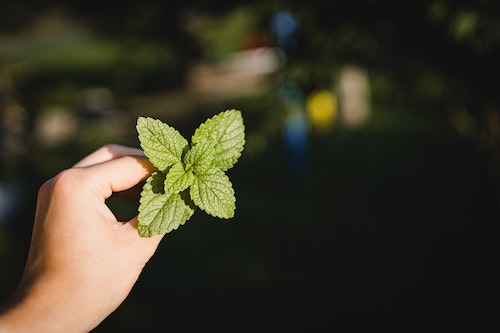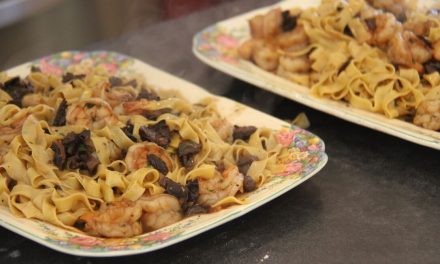 By Adam Centamore.
By Adam Centamore.
If you’re like me, you planted herbs in the spring. A lot of herbs.
Visions of handfuls sprucing up pasta salad danced before my eyes. Gorgeous, plump leaves of basil riding high on stacks of fresh mozzarella and ripe tomatoes. Tangy cilantro mingling with roasted white onion, chiles, and tomatillos to make the perfect summer salsa. The possibilities seemed almost endless, and so seed after seed was planted.
Now that summer is behind us, there are herbs remaining. A lot of herbs. Decisions need to be made about what to do with the aromatic jungle on my porch. Where some see an eventual addition to the compost pile, I see lots of opportunities to not only elevate my autumn cooking but also enjoy everything I love about fresh herbs for the rest of the year.
Here are six ways I will make the most of that herbaceous bounty:

herbal chimichurri steak sauce
1. Sauce
My first choice with surplus herbs is to use more in my cooking. Yes, they can be dried and turned into lots of tasty treats, but herbs are at their absolute best when they are enjoyed as fresh as they possibly can be.
Late in the season, sauces are a great way to use more herbs. There are tons of recipes beyond pesto, as well. South American chimichurri is always a favorite. The incredibly fragrant blend of flat-leaf parsley, garlic, pepper flakes, red wine vinegar, and sea salt is found everywhere grilled steaks are served. Houston’s Tex- Mex food trucks offer a spicy-creamy blend of jalapenos, olive oil, garlic, lime juice, and tons of pureed cilantro to slather on fresh tacos. Moroccan chermoula sauce combines cilantro, mint, and parsley with toasted cumin and coriander for an earthy, spicy marinade for seafood. Make sure to save some to drizzle on grilled kebabs.
 2. Pesto
2. Pesto
Pesto usually conjures up images of a bright green sauce made from basil, garlic, pine nuts, grated cheese, and olive oil. Rich and incredibly aromatic, it’s amazing atop grilled fish, mixed with penne pasta, or slathered on grilled bread with roasted tomatoes.
This pesto alla Genovese is a classic, but far from the only recipe. The word “pesto” comes from the Italian verb pestare (“to crush or pound”), which means that almost anything is possible. It’s not just about basil! Mint, parsley, cilantro…all these make fantastic pesto sauces. Feel free to blend in other flavors. Some of my favorites are sorrel with lemon juice and walnuts (especially spooned atop a fresh ball of burrata cheese), cilantro with coconut and cashews, and parsley with olives and toasted pistachios.
As a bonus, pesto also freezes really well. Use a spare ice cube tray to create single portions that can be thawed individually.
3. Compound Butter
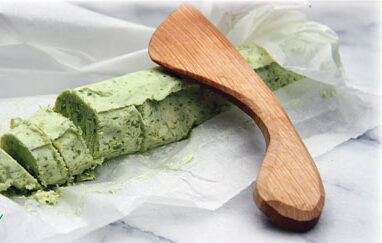
Herbed Butter
A stick of butter can be so much more than just a…stick of butter. It’s practically an edible canvas complementing the other flavors you can add to it. And compound butter is easy to make. Simply let a stick of butter soften (salted or unsalted, either is fine). Mix it with whatever you like, wrap it up in a piece of waxed paper or parchment, and refrigerate it until it’s firm.
Cilantro mixed with lime zest and some minced jalapeno pepper makes a wonderful topping for sizzling cuts of flank steak. Minced sage leaves and crushed blueberries make a richly-colored butter that sends freshly-baked biscuits to another level. Lemon juice and chopped basil butter tossed with tortellini make for a super-easy autumn dish.
When refrigerated, compound butter lasts for a week or so. Frozen butter lasts around three months. Simply cut off the amount of butter needed and smear it right onto the hot food to melt it. One last piece of advice is to use the best butter possible. It really makes a difference in flavor and texture.
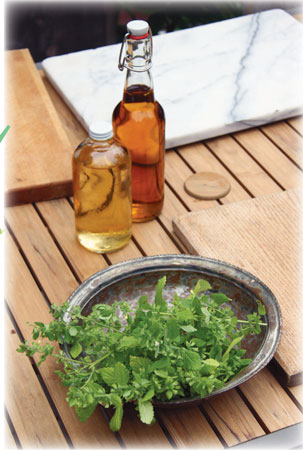 4. oils
4. oils
Like vinegar, infusing olive oil with herbs is a great way to introduce their subtle flavor into your dishes. Rinse and dry them well, then cover them with a good extra-virgin olive oil and store in a cool, dry place for ten days or so. Then remove the herbs and start drizzling!
Combine fresh basil, garlic, and a few sundried tomato slices for olive oil with an Italian flair. Feeling Mediterranean? Try mint with lemon peel and black peppercorn. Rosemary and orange peel add gorgeous aromas and flavor to a salad. The combinations are nearly endless.
Infused olive oils don’t last as long as their plain cousins. If kept in a cool, dry place they last for around a month before developing off-flavors and aromas.
5. Vinegar
Herb-infused vinegars are an easy way to take salads from good to great, and they couldn’t be easier to make. Simply rinse and dry a cup of your favorite herbs and put them in a bottle or sealable plastic container with three cups of vinegar. Shake it up a bit and store in a cool, dry place for 10 to 12 days. Remove the herbs and store the vinegar in the fridge for up to three months.
Try to avoid any strongly-flavored vinegars—apple cider, while delicious, has a very dominant flavor that could overpower the herbs. Look for something milder like Champagne vinegar. Rice wine or red wine vinegar are fine, and even sherry vinegars work well. Some of my favorite combinations are lemon verbena and Champagne vinegar, thyme and red wine vinegar, and lavender in rice wine vinegar.
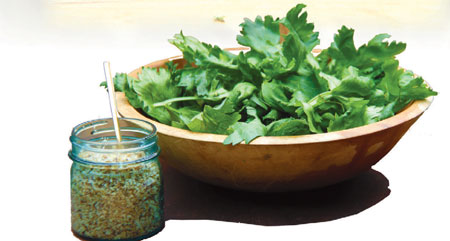 6. Salts
6. Salts
Once you’ve experienced herbed salt, it’s really difficult to go back to the plain old stuff. Sprinkled over chops on the grill, tossed into salads, and even adorning the rims of icy margaritas, this versatile salt is a great way to preserve summer’s herbaceousness.
Making herbed salt is easy. Choose your herbs and set them in the sun on a nice dry day. This step is important because too much moisture will dilute some of the salt. (If done on a high humidity day it will result in a puddle of brine.) When they are dry to the touch, combine them with salt in a food processor and pulse it a few times until well blended. Spread the mixture in a thin layer on a sheet tray or plate and let it air-dry for a few hours. Stored in an airtight container, the salt will last for months.
Any herbs can be used. A single herb will emphasize a particular flavor, blends will give a broad herbaceousness to the salt. As for the type of salt, I tend to use coarse sea salt. The larger chunks break down a little in the food processor. The final result is perfect for finishing grilled vegetables, mixing into salad dressings, and even tossing a teeny bit on a slice of late-season melon for a savory-sweet treat! Summer lives on!
Adam Centamore is a culinary educator, author, and writer on the South Shore, and can be reached through his website, www.eatdrinklearn.com. When Adam’s not teaching or traveling, he can be found listening to DIY audiobooks while grilling at home.

